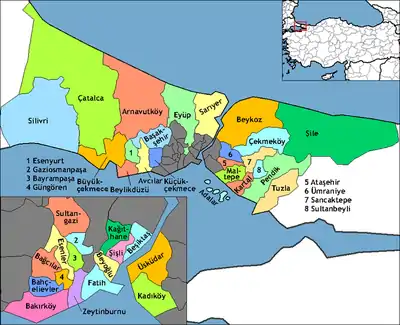Zeytinburnu
Zeytinburnu (literally, Olive Cape) is a working-class neighbourhood, municipality (belediye) and district on the European side of İstanbul, Turkey, on the shore of the Marmara Sea just outside the walls of the ancient city, beyond the fortress of Yedikule. The mayor is Ömer Arısoy (AKP).
Zeytinburnu | |
|---|---|
district | |
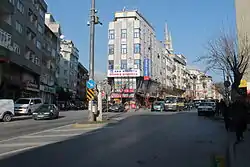 Dikilitaş neighborhood of Zeytinburnu | |
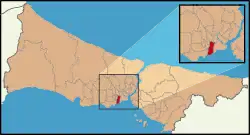 Location of Zeytinburnu in Istanbul | |
 Zeytinburnu Location of Zeytinburnu in Istanbul | |
| Coordinates: 40°58′59″N 28°53′59″E | |
| Country | Turkey |
| City | Istanbul |
| Government | |
| • Mayor | Ömer Arısoy (AKP) |
| • Governor | Selim Cebiroğlu |
| Area | |
| • District | 12.08 km2 (4.66 sq mi) |
| Population (2012)[2] | |
| • District | 292,407 |
| • District density | 24,000/km2 (63,000/sq mi) |
| Time zone | UTC+2 (EET) |
| • Summer (DST) | UTC+3 (EEST) |
| Area code(s) | 0–212 |
| Website | www |
History
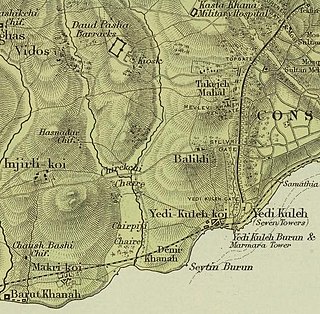
Zeytinburnu was a fortress and settlement known as Kyklobion (Greek: Κυκλόβιον) or Strongylon (Στρογγυλόν) during the Byzantine period, its name referring to the circular shape of the fortress.[3]
The fortress was built in Late Antiquity as part of a series of strongholds that guarded the coastal road leading to Constantinople. It is first attested during the reign of Justinian I (527–565). Kyklobion was used as the landing-site of the Arab armies on both of their assaults on Constantinople, in 674 and in 717.[3] In the early 8th century, the iconodule Saint Hilarion was kept prisoner in the local monastery on the orders of Emperor Leo V the Armenian (r. 813–820).[3] The site is again, and for the last time in Byzantine times, mentioned in a property deed of 1388.[3]
After the Fall of Constantinople in 1453, the name Kyklobion was transferred to the Yedikule Fortress by the local Greeks, and the original site was abandoned. Ruins of the original circular fortress survived until the 19th century, where the Austrian traveller Hammer-Purgstall saw them. Its name at the time was called in Greek Elaion Akra, "Cape of the Olive Trees"; the modern Turkish name has the same meaning.[3]
From the early 19th century onwards Zeytinburnu was an industrial village, centred on the leather industry of the area called Kazlıçeşme, which being on the coast with a good water supply was well suited to leather production. (the area was named for a fountain with a goose carved into the stonework, the fountain is still in existence). Up until the mid-20th century the residents were an urban mix of Greeks, Armenians, Bulgarians, Jews and Turks and still today the Yedikule Surp Pırgiç Armenian Hospital is active in Kazlıçeşme, and has a museum in the grounds.[4]
The character of Zeytinburnu changed when a large wave of immigrants from Anatolia came and settled there from 1950 on. Zeytinburnu is an important lesson for city planning in Turkey, because it was one of the first Gecekondu districts. In other words, most of the buildings were built illegally, without infrastructure, and without any aesthetical concern. In the 1960s legislation was passed to prevent this type of building but by then this type of development had become unstoppable. At first these were little brick-built single storey cottages. From the 1970s onwards the little houses were replaced by multi-storey concrete apartment blocks built in rows with no space in between. In most cases the ground floor was used as a small textile workshop, and thus Zeytinburnu became a bustling industrial area with a large residential population living above the workshops. All this was still illegal and unplanned and still lacked the infrastructure and the aesthetics. After a heavy rain the streets would run with dirty water for days.
Floor mosaics discovered during the restoration of the Zeytinburnu Kazlıçeşme Cultural Center. The mosaics are from the Late Roman and early Byzantine period.[5]
Historical places
- Balıklı
- Holy Spring
- Balıklı Church
- Balıklı Greek Hospital
- Çırpıcı Meadows
- Kirazlıçeşme Fatih Mosque
- Hacı Mahmud Ağa Dervish Lodge
- Kazlı Çeşme (Goose Fountain)
- Merkez Efendi Dervish Lodge
- Merzifonlu Kara Mustafa Pasha Masjid
- Perişan Baba Dervish Lodge
- Seyyid Nizam Dervish Lodge
- Walls of Constantinople
- Yedikule Surp Pırgiç Armenian Hospital
- Takkeci İbrahim Ağa Mosque
- Yenikapı Mevlevîhane
- Zeytinburnu Military Hospital
- Cemeteries in Zeytinburnu
Zeytinburnu today
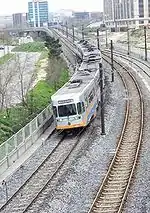
The leather industry has largely moved out to Tuzla now but the rows of six-storey blocks of housing and textiles remains. Although some improvements have been made to the streets and drainage the area still has a reputation for being the home of tough men and uncontrollable youths who drive around in cars blasting out pop music at high-volume. Possibly this is exaggerated nowadays, and steps are being taken to smarten up the area. Most residents are working class, recent migrants from Anatolia, typically lacking in education. However, the younger generations are more educated thus changing the shape of Zeytinburnu.
To integrate the district with the rest of Istanbul, the municipality has improved the transportation by extending the modern tram line to Zeytinburnu, and the main tram station is now at the intersection of the metro line leading to Atatürk International Airport and Aksaray and fast tram lines leading to Istanbul's inter-city coach station and the old city in Eminönü. Moreover, Zeytinburnu has a station on the suburban railway line Sirkeci-Halkalı. Other important projects have improved the transportation, life quality and the economics of the district. Olivium Outlet Center was opened in 2000 [7] , a modern shopping mall with cinemas, but with many shops specializing in factory surpluses, this has brought new shopping opportunities for the people of Zeytinburnu and surrounding districts, it's very crowded at weekends.
There is an Alevi community served by the Erikli Baba Cemevi[8]
There are large minority groups of Kazakhs and Turkmens,[9] who generally work in the textile, clothing industry contributing to the Turkish economy.
The Zeytinburnu-based NASCO NASREDDIN HOLDING A.S. was categorized as an Al-Qaeda ally by the United Nations.[10][11][12][13][14] It was involved in terrorist finance.[15] The Romanian government legislated this status for Zeytinburnu Nasco Nasreddin Holding A. S.[16] and the Slovakian government.[17][18]
On December 10, 2014, in Zeytinburnu, an assassin killed the anti-Uzbekistan government Islamist Uzbek Imam Shaykh Abdullah Bukhoroy (Abdullah Bukhari).[19][20][21][22][23][24][25] It took place outside of a Madrassa.[26] The Islamist organization Hizb ut-Tahrir released statements on Islamist websites which attacked the Uzbekistan government of Islam Karimov and blamed them for the assassination.[27][28] The Uyghur Eastern Turkistan Education and Solidarity Association (ETESA) and Uzbek Islamist exiles demonstrated against the assassination and denounced Putin and the Uzbek government under Karimov in the Fatih district of Istanbul.[29]
Turkish connections were used by Uyghur fighters to go into Syria (Turkistan Islamic Party in Syria) and the humanitarian Uyghur Eastern Turkistan Education and Solidarity Association (ETESA) which is located in Turkey sent Uyghurs into Syria, endorsed the killing of the pro-China Imam Juma Tayir, applauded attacks in China, and posted on its website content from the Turkistan Islamic Party.[30] Turkish passports were used by Uyghurs who were seeking to contact Mujahidin Indonesia Timor, a pro-ISIS organization in Sulawesi in Indonesia.[31]
The Turkish run English language BGNNews news agency reported that the Turkish Meydan newspaper discovered that Uyghur fighters joining the Islamist terrorist organization ISIL were being helped by businessman Nurali T., who led an Zeytinburnu district based network in Istanbul, which produced counterfeit Turkish passports numbering up to 100,000 to give to Uyghurs from China and help them go to Turkey form where they would enter Iraq and Syria to join ISIL, Uyghurs from China travel to Malaysia via Cambodia and Thailand and then travel onto Turkey, since a visa is not needed for travel between Turkey and Malaysia, then staying at locations in Istanbul, and then going to Iraq and Syria by traveling to southeastern Turkey, the information was revealed by AG who participates in the network, he noted that even though Turkish authorities are able to detect the fake passports they do not deport the Uyghurs and allow them into Turkey, AG said that: “Turkey has secret dealings with the Uighurs. The authorities first confiscate the passports but then release the individuals.”[32] Uyghurs were routed into Syria by way of Zeytinburnu by Turkey.
The Uyghur diaspora in the Küçükçekmece, Sefaköy, and Zeytinburnu districts of Istanbul, Turkey, are the source of Uyghur Turkistan Islamic Party Jihadists in Syria.[33][34] The Turkey-based Uyghur website "Doğu Türkistan Bülteni", which supports the Turkistan Islamic Party, reported that the Uyghur diaspora in Küçükçekmece and Zeytinburnu were in fear after the assassination of Uzbek Imam Abdullah Bukhari and the Uyghurs were panicking over reports of Chinese loyalist Uyghur agents sent to Istanbul to hunt down separatist Uyghurs as Russia, Iran, and Assad were fighting against the Turkmens and Turkestan Islamic Party Uyghur fighters.[35][36]
The funeral of the Turkish Nationalist Movement Party member İbrahim Küçük took place in Zeytinburnu after he died due to Russian bombing in the Jabal al Turkman area of Syria.[37][38][39][40]
Uyghur workers at a restaurant provided money in Zeytinburnu to the terrorist who committed the nightclub massacre at Reina for his taxi fare. The Seferoğlu Sokak based Uyghurs in Zeytinburnu[41] aided the attacker when he fled the nightclub. The 7 Uyghurs were arrested by Turkish police.[42][43] Zeytinburnu became the site of over 50 police sweeps against "East Turkistanis" (Uyghurs), Kazakhs, Kyrgyz, and Uzbeks. Zeytinburnu is infamous for being used by Syria destined jihadists as a transit point.[44] A Uyghur committed the nightclub attack according to Turkish news.[45] Turkish news said he was from ISIS's "East Turkestan" arm.[46][47] Erdoğan's government has deliberately facilitated the travel of Jihadist Uyghurs through Zeytinburnu, with Turkish intelligence involved and the nightclub massacre at Reina is a result of this.[48] Uzbeks and Uyghurs reside in Zeytinburu's Yenidoğan area where the attacker fled to[49] in addition to Syrians.[50] Istanbul's Uyghurs aided the attacker[51] The restaurant was owned by Şemseddin Dursun.[52] Xinjiang was the origin of the attacker.[53] The attacker's wife was interrogated.[54] He went to Konya with his children and wife from Kyrgyzstan via Istanbul.[55] In Başakşehir and Zeytinburnu he contacted ISIL.[56] Turkey nabbed Abuliezi Abuduhamiti and Omar Asim, both Uighurs.[57] There are more than 100,000 Xinjiang and Central Asian origin unregistered people in Zeytinburnu.[58]
Doğu Türkistan Bülteni Haber Ajansı, which supports the Uyghur group Turkistan Islamic Party complained about the Reina massacre suspect being named as Uighur by Veysi Kaynak, the Deputy Prime Minister, blaming Fethullah Gülen and “FETÖ” for the attack.[59] Doğu Türkistan Bülteni Haber Ajansı, speaking on behalf of the TIP, pledged its animosity against Russia and the PKK, saying it fought them alongside Turkmen in Syria for 6 years, denying involvement in the Reina nightclub massacre and trying to blame China for the massacre, claiming that Uyghurs in Küçükçekmece and Zeytinburnu were being unfairly targeted.[60] Doğu Türkistan Bülteni Haber Ajansı and Zeytinburnu Uyghurs blamed FETO and Fetullah Gulen for the Reina nightclub massacre.[61]
Küçükçekmece, Başakşehir, Bağcılar, Gaziosmanpaşa, Esenler, Bayrampaşa, Zeytinburnu, and Fatih are home to refugees of Syrian origin.[62]
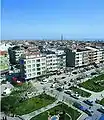 General view
General view Zeytinburnu Cultural and Art Center
Zeytinburnu Cultural and Art Center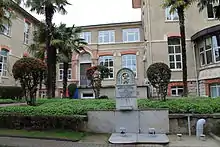 Armenian Hospital
Armenian Hospital The community mosque of Turks of Western Thrace
The community mosque of Turks of Western Thrace Hat Boyu Street and leather shops
Hat Boyu Street and leather shops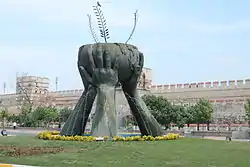 Belgrad Gate
Belgrad Gate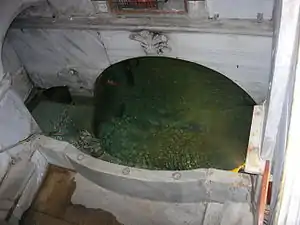 Holy Fishes in Greek Church Balıklı
Holy Fishes in Greek Church Balıklı
Sports
Teams
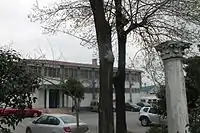
- Football
In the early 1990s, the Zeytinburnuspor, a top-flight football team, is now languishing in the minor leagues. Arif Erdem and Emre Belözoğlu started their careers here. Matjaž Cvikl (1967–1999), Slovenia national football team player, who died just a few years after played there also.
The women's football team played once in the Turkish Women's First Football League.
- Ice hockey
The 2010-established men's ice hockey team of Zeytinburnu Belediyespor finished the 2013–14 Turkish Ice Hockey Super League (TBHSL) season as the runner-up. They became twice champion in the following 2014–15 and 2015–16 seasons.[63][64]
Venues
The 16,000 seating capacity Zeytinburnu Stadium is home to the football teams of Zeytinburnu.[65]
The Zeytinburnu Ice Rink, opened in 2016, is a mobile ice rink, which hosted the home 2015–16 season matches of the Zeytinburnu Belediyespor ice hockey team.[66]
Town twinning
Zeytinburnu is twinned with:
References
- "Area of regions (including lakes), km²". Regional Statistics Database. Turkish Statistical Institute. 2002. Retrieved 2013-03-05.
- "Population of province/district centers and towns/villages by districts - 2012". Address Based Population Registration System (ABPRS) Database. Turkish Statistical Institute. Retrieved 2013-02-27.
- Külzer, Andreas (2008). Tabula Imperii Byzantini: Band 12, Ostthrakien (Eurōpē) (in German). Vienna: Österreichische Akademie der Wissenschaften. pp. 484–485. ISBN 978-3-7001-3945-4.
- "Official homepage" (in Turkish). Surp Pırgiç Ermeni Hastanesi. 2009. Retrieved 2009-08-26.
- Roman and Byzantine era mosaics in Kazlıçeşme
- "Official homepage". Zeytinburnu District Portal. 2010. Retrieved 2010-08-16.
- "Official homepage". Olivium Outlet Center. 2010. Retrieved 2010-08-16.
- "Official homepage" (in Turkish). Erikli Baba Cemevi. 2010.
- "Official homepage" (in Turkish). Easternturkistan Migration Association, Zeytinburnu. 2010.
- "Archived copy". Archived from the original on November 15, 2013. Retrieved February 22, 2016.CS1 maint: archived copy as title (link)
- https://www.un.org/News/Press/docs/2002/sc7494.doc.htm
- https://www.un.org/press/en/2007/sc9172.doc.htm
- https://www.un.org/press/en/2002/sc7494.doc.htm
- http://www.unis.unvienna.org/unis/en/pressrels/2002/sc7494.html
- https://wikileaks.org/plusd/cables/03ANKARA2332_a.html
- Romania (May 2004). Monitorul oficial al României: Legi, decrete, hotărîri și alte acte. Parlamentul României, Adunarea Deputaților. p. 26.
- Slovakia (2003). Zbierka zákonov Slovenskej republiky. Ministerstvo spravodlivosti Slovenskej republiky. p. 1436.
- Slovakia (2003). Zbierka zákonov Slovenskej republiky. Ministerstvo spravodlivosti Slovenskej republiky. p. 1052.
- "Radical Uzbek Imam Shot Dead In Istanbul". RadioFreeEurope/RadioLiberty. Retrieved 26 December 2015.
- http://www.dailysabah.com/nation/2014/12/13/russian-suspect-nabbed-in-uzbek-preachers-murder
- "Turkey: Russian citizen detained in connection with Uzbek imam assassination in Istanbul – Ferghana Information agency, Moscow". Retrieved 26 December 2015.
- "Turkey: "Uzbek imam" murder video emerges – Ferghana Information agency, Moscow". Retrieved 26 December 2015.
- "Alleged organizers, killers of Uzbek imam in Turkey arrested, named – Ferghana Information agency, Moscow". Retrieved 26 December 2015.
- "Four more dissident Uzbeks are on assasination [sic] list -report – Asia-Pacific – Worldbulletin News". World Bulletin. Retrieved 26 December 2015.
- "Uzbekistan: Swedish Trial Features Testimony About Alleged International Assassin Network". EurasiaNet.org. Retrieved 26 December 2015.
- "Have Russian hitmen been killing with impunity in Turkey?". BBC News Magazine. 13 December 2016.
- http://www.khilafah.com/imam-abdullah-bukhari-may-allah-have-mercy-on-him-assassinated-in-istanbul/
- "VIDEO: Sheikh Abdullah Bukhari shot dead in Istandbul". 5Pillars. Retrieved 26 December 2015.
- http://turkistanlilar.org/%D0%B8%D1%81%D1%82%D0%B0%D0%BD%D0%B1%D1%83%D0%BB%D0%B4%D0%B0-%D1%82%D1%83%D1%80%D0%BA%D0%B8%D1%81%D1%82%D0%BE%D0%BD%D0%BB%D0%B8%D0%BA-%D0%BC%D1%83%D2%B3%D0%BE%D0%B6%D0%B8%D1%80%D0%BB%D0%B0%D1%80%D0%B3/
- Zenn, Jacob (10 October 2014). "An Overview of Chinese Fighters and Anti-Chinese Militant Groups in Syria and Iraq". China Brief. The Jamestown Foundation. 14 (19). Archived from the original on 18 June 2015. Retrieved 14 June 2015.
- Zenn, Jacob (10 October 2014). "An Overview of Chinese Fighters and Anti-Chinese Militant Groups in Syria and Iraq". China Brief. The Jamestown Foundation. 14 (19). Retrieved 14 June 2015.
- "ISIL recruits Chinese with fake Turkish passports from Istanbul". Istanbul. BGNNews. April 9, 2015. Archived from the original on September 25, 2015. Retrieved 4 June 2015.
- http://www.islahhaber.net/uygur-ajan-rabia-kadir--dogu-turkistanli-mucahidleri-ihbar-etti-42554.html
- "Archived copy". Archived from the original on 2016-02-01. Retrieved 2016-01-28.CS1 maint: archived copy as title (link)
- "Archived copy". Archived from the original on 2016-01-19. Retrieved 2016-02-15.CS1 maint: archived copy as title (link)
- "Archived copy". Archived from the original on 2015-11-28. Retrieved 2016-02-15.CS1 maint: archived copy as title (link)
- "Archived copy". Archived from the original on January 28, 2016. Retrieved January 28, 2016.CS1 maint: archived copy as title (link)
- http://en.haberler.com/killed-in-syria-mhp-deputy-district-head-s-funeral-876409/
- https://www.youtube.com/watch?v=CrwVXL8nuRo
- https://www.youtube.com/watch?v=V0e4bosjpYI
- Bozkurt, Abdullah [@abdbozkurt] (3 Jan 2017). "Then, he got into the second cab, driven to an alley 'Şuayip Seferoğlu Sokak' where an Uyghur Restaurant located in Zeytinburnu district" (Tweet) – via Twitter.
- Stojanovic, Dusan (January 4, 2017). "Turkey identifies gunman in Istanbul nightclub shooting". Associated Press. ISTANBUL.
- Bozkurt, Abdullah [@abdbozkurt] (3 Jan 2017). "He paid off the driver with the money he borrowed from the Uyghur employees of this restaurant. Police detained seven restaurant workers" (Tweet) – via Twitter.
- ULUDAĞ, NİHAT (4 January 2017). "Reina'ya saldıran teröristin katliam sonrası rotası..." HABER İÇİN HABERTÜRK (in Turkish).
- "Turkish media releases video of suspected nightclub gunman, claims he is Chinese Uygur Muslim". South China Morning Post. 3 January 2017.
- Robson, Steve; Rkaina, Sam; Bishop, Rachel; Milanian, Keyan (2 Jan 2017). "Istanbul nightclub ISIS attack: Recap as ISIS claims responsibility for gun attack that left 39 dead". The Mirror.
- Wellman, Alex; Robson, Steve; Bishop, Rachel (1 Jan 2017). "First picture of Istanbul terror suspect after gunman 'screamed Allahu Akbar' as he slaughtered 39 in Turkish nightclub". The Mirror.
- Bozkurt, Abdullah (January 3, 2017). "[OPINION] How Erdoğan empowered jihadists from China". Turkish Minute.
- Bozkurt, Abdullah [@abdbozkurt] (3 Jan 2017). "The killer stayed shortly in 'Yenidoğan' neighborhood in Zeytinburnu district of Istanbul where Uyghur, Uzbek & Afghans refugees live" (Tweet) – via Twitter.
- Bozkurt, Abdullah [@abdbozkurt] (3 Jan 2017). "The neighborhood the killer had stayed before the carnage at night-club has not only refugees from Central Asia but also from Syria" (Tweet) – via Twitter.
- Bozkurt, Abdullah [@abdbozkurt] (3 Jan 2017). "The killer of night-club reportedly drew support from local Uyghur community in Istanbul, #Turkey, as more details have emerged on the case" (Tweet) – via Twitter.
- Bozkurt, Abdullah [@abdbozkurt] (4 Jan 2017). "Şemseddin Dursun, the owner of Uyghur restaurant where the night-club attacker allegedly picked up a cab fare, denies all accusations" (Tweet) – via Twitter.
- Bozkurt, Abdullah [@abdbozkurt] (1 Jan 2017). "He looks more like somebody from Central Asia or Chinese Xinjiang region. #ISIL accounts says he made it out safely" (Tweet) – via Twitter.
- Bozkurt, Abdullah [@abdbozkurt] (3 Jan 2017). "The testimony of the wife of the #ISIL killer who murdered 39 people in night club in Istanbul provides further details on the background" (Tweet) – via Twitter.
- Bozkurt, Abdullah [@abdbozkurt] (3 Jan 2017). "The killer came to Istanbul from #Krygzstan on a flight on 20 Nov with his wife and two kids, moved to conservative province Konya on 22nd" (Tweet) – via Twitter.
- Bozkurt, Abdullah [@abdbozkurt] (3 Jan 2017). "The killer traveled to Istanbul on 29th, believed to have interacted with ISIL cells in Istanbul's Zeytinburnu and Başakşehir districts" (Tweet) – via Twitter.
- "Turkey arrests two Chinese Uighurs over Istanbul nightclub attack". REUTERS. 2017-01-14.
- Gurcan, Metin (January 13, 2017). "'Devotees of Death' headed for Turkey". Al-Monitor.
- "Başbakan Yardımcısı Veysi Kaynak'a Cevap Uygurlardan Geldi; Kardeşimiz Dediğiniz DUK Fetö'cü, Bunu Biliyormusunuz". Doğu Türkistan Bülteni Haber Ajansı.
- "Komünist Çin, Türkiye'de Sansasyonel Eylem Yapmayı Planlıyor". Doğu Türkistan Bülteni Haber Ajansı.
- "ORTAKÖY KATLİAMINI FETÖ'CÜLER Mİ AYDINLATACAK ?". Doğu Türkistan Bülteni Haber Ajansı.
- HAYATA DESTEK (31 August 2013). Syrian Refugees in Turkey (PDF) (Report). SUPPORT TO LIFE. pp. 4–5.
- "Zeytinburnu Belediyesi Buz Hokeyi Takımı Şampiyon Oldu". Milliyet (in Turkish). 2015-06-05. Retrieved 2016-05-01.
- "Buz Hokeyinde Şampiyon ZEwytinburnu Belediye". Milliyet (in Turkish). 2016-05-01. Retrieved 2016-05-01.
- "Zeytinburnu Stadi". worldstadiums.com. Retrieved 2016-05-04.
- "Türk Buz Hokeyi'nde Bir İlk". Son Dakika (in Turkish). 2016-02-06. Retrieved 2016-05-04.
External links
| Wikimedia Commons has media related to Zeytinburnu. |
- District governor's official website (in Turkish)
- District municipality's official website (in English)
